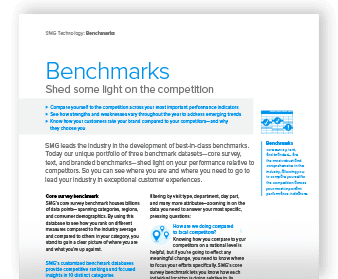Top CX benchmarks for retailers
Published on Aug 17, 2022

A successful customer experience (CX) program doesn’t just measure how your brand is performing, but how it’s performing against its biggest competitors. Customer experience benchmarks are the tools brands need to compare standardized metrics—either internally against past performance or externally against the scores of competitors.
Though benchmarks won't make or break your business, they do have a place in your CX strategy. Benchmarks provide additional insights and a supplemental perspective to your own customer feedback. And brands that have access to robust customer experience benchmarking are at an advantage over those that don’t—learning what’s really important to consumers, where they’re coming up short, and where to focus efforts to move up.
CX benchmarking standards
In this blog, we’ll provide an overview of the customer experience benchmarking standards every company should expect from their customer experience provider. Then we’ll dig a little deeper and identify specific benchmarks every retail brand should be tracking to stay ahead of competitors. And finally, you’ll get two real-life examples of retail brands leveraging benchmarks to refocus their CX strategy and score big wins.
Core survey benchmarks
With access to a core survey benchmark database—spanning categories, regions, and consumer demographics—you get a blinded rank on different measures compared to the industry average and to others in your category. This helps paint a clearer picture of where you are and what you’re up against. Additionally, be sure you’re not restricted to the brand level so you’re able to dig deeper into the data—filtering by visit type, department, day part, and other important attributes—zooming in on what you need to answer your most specific, pressing questions.

A retailer’s guide to best-in-class benchmarking
Qualitative benchmarks
Qualitative benchmarks provide the data behind customers’ open-ended comments gathered at any unsolicited touchpoint (e.g., call center, ratings + reviews). You can use this data to gain deeper understanding of the customer experience and see what customers are saying about your brand vs. other brands within the category.
For example, qualitative benchmarks will help you answer:
- How often are customers talking about important measures in your locations?
- How often are customers mentioning an employee’s name and how does that affect Overall Satisfaction?
- What is the percentage of customers talking negatively about your staff?
- In what categories (e.g., Staff Friendliness, Speed, Cleanliness) do customers think you’re better—or worse—than the rest?
Being able to see what customers are mentioning, as well as the sentiment behind their comments, gives you qualitative context about how they feel to help you flesh out the numbers from the core survey benchmark.
Branded benchmarks
With the core survey and text benchmarks, you know everything about how your customers rate you compared to how your competitors’ customers rank them. But which competitors are you comparing against? Branded benchmarks answer that question by showing you exactly where your brand falls on customer experience metrics and what share of visit you’re winning from specific competitors.
With just a few clicks, you can sort the data to get insights about demographics, regions, or time of visit. And, you can learn what motivates consumers so you can see exactly where you stand among your competitors. Branded benchmarks turn your most specific questions into your most focused insights—instantly.
Top retail CX benchmarks
Now that you have a better understanding of the general benchmarking standards you should be seeking out, let’s dig into the top benchmarks impacting the retail industry today.
Overall experience benchmarks: Start with the basics
- Overall Satisfaction: The holy grail of customer experience measurement scores
- Overall Value: A very hot topic in retail right now, this measure is multifaceted—taking into account both quality and service in relation to price
- Likelihood to Recommend: A big indicator of customer loyalty
- Associate Friendliness: Take a look at this one in relation to Overall Value; this is part of the service piece that can differentiate your brand from competitors + increase value perception
- Speed of Checkout: A key measure for every retailer and one you should be prioritizing to keep up with evolving customer expectations on frictionless experiences
- Product Availability: Another pressing issue in the retail industry and a top predictor of Overall Satisfaction—seeing how you’re performing against your competitors is key. While much of product availability is out of the hands of your field teams, there are several ways your staff can mitigate low inventory issues:
- Truck Recovery – When a truck comes in with product, the speed at which that inventory can be brought out onto shelves makes a big difference. Customers can’t purchase items that are in the back room.
- Organization and cleanliness – When stores are cluttered or shelves are in disarray, customers have a harder time finding products so keep things tidy. Also don’t keep extra (unpacked) inventory in the aisles (it’s not on the shelves where a customer can see it and it’s blocking inventory that is on the shelf).
- Assistance – When employees are available and offering assistance, they can help customers find products they are looking for. They can also offer solutions such as ordering the item online or provide an alternate product
On-site benchmarks: Go a cut deeper
- Trip motivation: Get a better understanding of what got them in the door (e.g., convenient location, previous positive experience, coupon/promotion)
- Conversion: Learn where your brand doing a better job than competitors in turning potential customers into purchasers
- Geographic: Get a read on regional differences + uncover opportunities for lowest performing areas
- Self-checkout: A category common with grocery brands but gaining traction across the industry as other retailers implement the service
Omnichannel benchmarks: Close the gaps across touchpoints
- Ratings + Reviews: What are customers saying online about their experience with your brand? How are you performing on Facebook Recommendations? Are you responding to these reviews and maintaining a high response rate?
- BOPIS (buy online, pick-up in store): Aside from Overall Satisfaction, a key measure to look at here is Speed of Pick-up; customer expectations for this service have heightened since the pandemic + you need to know “How fast is fast enough?” for fulfilling BOPIS orders to remain competitive
- Digital orders: Key measures here are Overall Satisfaction and Overall Value
Visit share benchmarks: Where do you stand?
Branded benchmarks will help identify where you stand regarding share-of-visit against your main competitors. The key here is consistency—define your set of competitors and stick to it. Making changes to the set will disrupt the validity of the data so reach out to your CX team for help creating your core group of direct competitors.
Retailer Success Stories
Already an industry leader on most CX measures, this specialty retailer set out to find new ways to keep the needle moving up.
Regional Performance Gaps Identified Through Benchmarking
Using location-level data to investigate internal benchmarks and identify bottom performers, the team revealed opportunities for improvement in the West Coast DMA.
The analysis showed West Coast locations were underperforming on service standards, particularly when it came to offering additional items and answering customer questions. To help the brand make the case to the field, the SMG team used DMA-level industry benchmarks to confirm the issue stemmed from lack of front-line execution—not regional differences in clientele or customer expectations.
The brand implemented an action plan that included:
- Establishing specialized SMG training visits focused on service standard execution + its impact on Overall Satisfaction
- Training on report-building best practices
- Setting up CX program stations at each location to highlight scores + alerts
Sticking to the plan worked for the lagging West Coast DMA locations. They were able to drive an:
- 8.6 ppt-increase in comp sales (surpassing the system-wide average)
- Uptick in core CX measures including Offered Additional Items + Associates Answered Questions

Health and safety prioritization drives improvements
As non-essential retailers began to reopen following the COVID-19 lockdown, many brands implemented new procedures across locations—including distancing signage, larger aisle space, and cashier barriers—to help customers and associates feel safe in stores.
Eager to get a quick read on how customers felt about these measures, this retail brand added health + safety questions to their in-store customer survey and looked to their SMG team for insight.
Initial results indicated the new procedures were well-received—with drill-down analysis revealing most problems involved behavior of other customers (i.e., not wearing masks or adhering to social distancing rules).
Further analysis showed the new measures had a big impact on repeat business—when customers were highly satisfied with health + safety, they were 40ppts more likely to return.
With SMG’s branded benchmarks placing this retailer above average in their industry, the brand knew how important health + safety was to driving repeat business and set its focus on being best-in-class.
The brand took action by:
- Implementing mandatory mask mandates for all employees + customers across stores in July 2020
- Committing to continual prioritization of health + safety protocols for associates and customers
- Leveraging video feedback to gain insight on customers’ health + safety concerns while shopping in-store
The changes paid off with:
- #1 ranking in SMG’s industry benchmark for health + safety
- Exceeding holiday sales projections
- An increase in Overall Satisfaction
- Improved scores on Store Cleanliness

Partner for best-in-class benchmarks
It’s difficult to guide improvements and lead your industry when you don’t understand how customers rank you relative to the competition. By partnering with a CX provider that provides access to a portfolio of robust core survey, text, and branded benchmarks, retailers are able to:
- Compare their scores across their most important performance indicators
- See how strengths + weaknesses vary throughout the year to address emerging trends
- Know how customers rate their brand compared to competitors
Also keep in mind the best benchmark is your own historical performance. You need to be trending up over time. And if you're already close the top of your benchmark, you need to make sure your numbers are still trending high.
Download our benchmarks tech sheet
For more information on how benchmarks can help your brand get a leg up on the competition, download this tech sheet.
Related articles

How to demonstrate ROI on your CX program using customer journey analytics
Average share of wallet, return cycle, and cost of problem solving are important customer journey analytics that can help brands demonstrate ROI on their customer experience management platforms.

How car wash brands can satisfy shifting customer expectations
With more than 61,000 car wash facilities in the U.S., customers have no shortage of options when choosing a brand. The car wash segment of the automotive aftermarket services industry is expected to

How to stay customer-centric in a contactless world
While businesses adapt to the new normal created by COVID-19, it’s imperative to keep pace with a quickly evolving customer experience. As the expectations for low-contact or contactless shopping shif